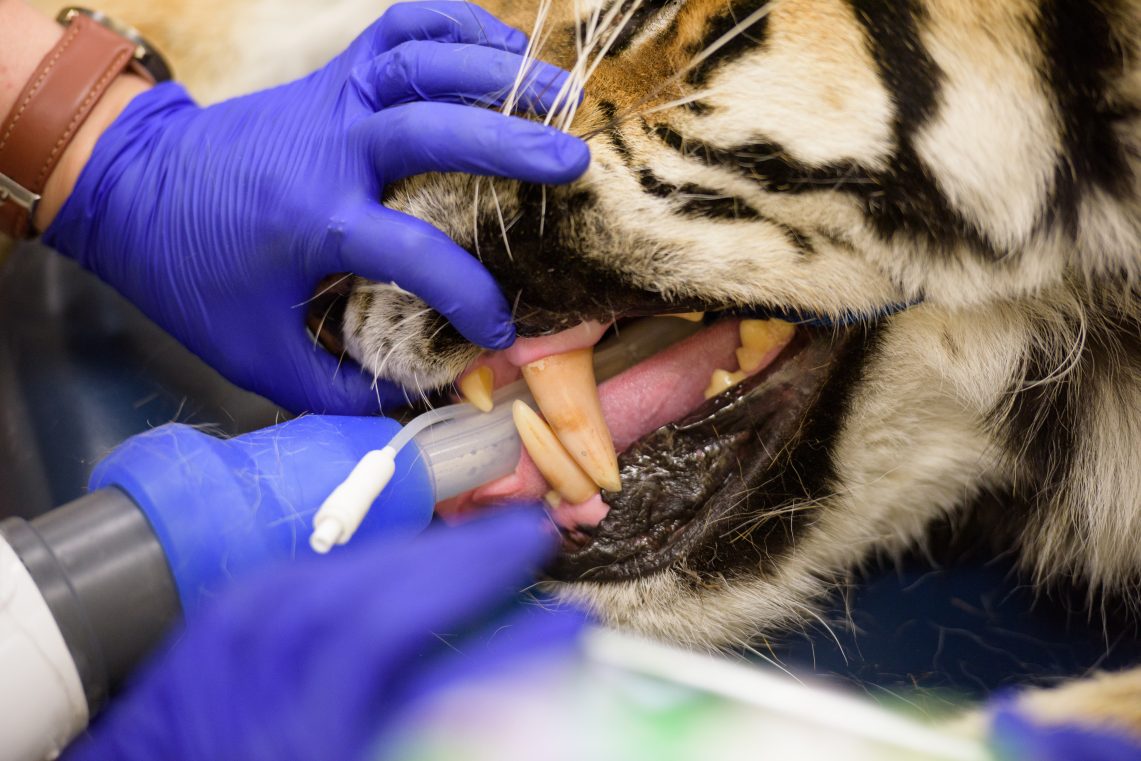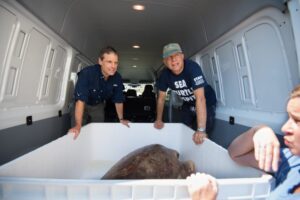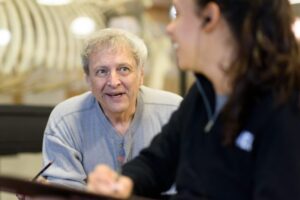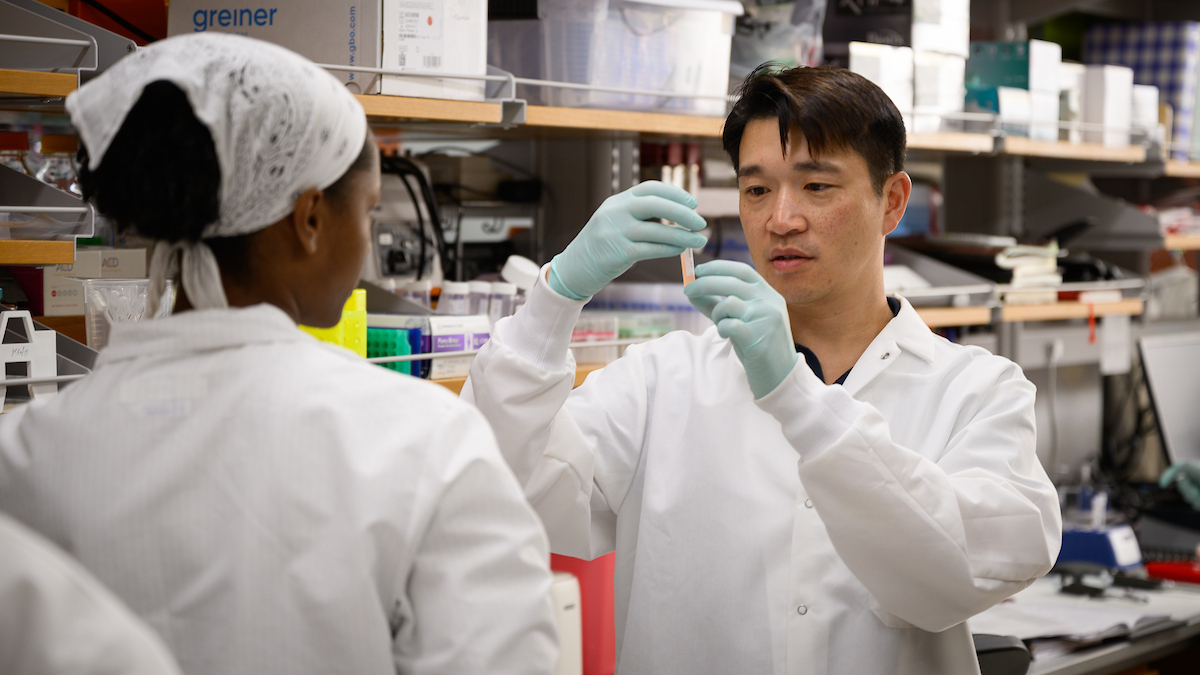Wild Things: 30 Years of Zoological Medicine at the CVM

The first time Michael Stoskopf was told he shouldn’t be a veterinarian was in high school.
He had taken a vocational aptitude test, one of those supposedly fortune tellers that revealed the job you are best suited for based on your answer to questions like, “Would you rather repair a car or paint a picture?”
“It came back that I should definitely be about 18 things,” said Stoskopf. “But it also had three things that I definitely should not be, and one of them was veterinarian.”
He was crushed. Becoming a veterinarian made sense to him. So he took another test, this one from a different publisher. He got the same results. What he definitely shouldn’t be: a veterinarian.
Eventually Stoskopf said he learned how the tests had been put together. One hundred successful veterinarians were given the test and then the test writers would do a straight correlation from their answers to student answers.
“It was a tool for maintaining the same thing that existed in each discipline — just be happy with it the same way everyone else is,” said Stoskopf. “But I have always been stubborn. I made my decision to go into veterinary medicine, high or hell water.
“And my vision was always that I was going to be a veterinarian in a different way.”
When Stoskopf was hired by the NC State College of Veterinary Medicine in 1989 to help develop and lead the school’s zoological medicine focus, it wasn’t even called that. Officially, he was leading the Department of Companion Animals and Special Species. At the time, most veterinary schools did not have zoological specialists on faculty or staff. Zoos and aquariums often had only a part-time veterinary consultant.
Simply the fact that CVM founding Dean Terrence Curtin advertised for such a position was enough to tell Stoskopf, now the CVM’s professor of aquatics, wildlife and zoological medicine, that the school was ahead of its time.
A year after Stoskopf was hired, Suzanne Kennedy-Stoskopf, his wife and fellow veterinarian, joined him at the CVM.
“Michael and I both approached zoological health with the idea that we were just going to make things better for wildlife,” said Kennedy-Stoskopf. “We didn’t specify how that was going to be done, but we were committed to doing it.”
Thirty years ago, they envisioned the CVM as the place for groundbreaking changes in zoological medicine. Thirty years later, it still is.
One Big Family
Taylor Gregory was working on a cramped fishing boat off South Carolina this summer when she began to realize she had no choice but to go into zoological medicine.
She had entered the CVM Class of 2021 with a declared mixed animal focus, generally chosen by students who want to work with little bit of everything. She thought about having a mobile veterinary practice that worked primarily with cats, dogs and horses. Maybe there’d be some wildlife on the side, she told herself.
But while she was catching, counting and releasing wild sea turtles with the South Carolina Department of Natural Resources, something began to change.
“We were only out there for three days, and I can’t remember a time I’ve been that happy,” said Gregory. “I was outside, my go-to happy place. I was doing work that mattered.”
Another summer adventure sealed the deal. Gregory got the chance to shadow a veterinarian at the Chattanooga Zoo during a snow leopard immobilization. She’s a big snow leopard fan. Last winter, she and some friends traveled from North Carolina to Michigan and back over a week, stopping at every zoo with a snow leopard. They called it Snowleopardpalooza, and it was made possible by Tara Harrison, a CVM assistant professor and clinician who called up her friends at the zoos asked for some favors. Her South Carolina work was also made possible with a little help from a CVM faculty member — Greg Lewbart, professor of aquatic animal medicine.
When Gregory arrived at the zoo, the veterinarian instead focused on a sick chimpanzee. She told the veterinarian that if any help was needed with the snow leopard, she would drive back. Two weeks later, she got a call.
“That’s when I realized that I needed to do zoological medicine,” said Gregory. “If I’m going to drive 30 hours to play with one animal in this field for two hours, why am I messing around with anything else?”
The CVM offers unparalleled experiences in zoological medicine. Students can release sea turtles back into the waters lapping North Carolina and then study them further at NC State’s Center for Marine Sciences and Technology. They research black bears in the Blue Ridge Mountains. They manage red wolves, providing daily husbandry and practicing preventive medicine. The students also get to breed red wolves, contributing to the hopeful restoration of the critically endangered species.

CVM graduates are veterinary leaders at the North Carolina Zoo, the North Carolina Museum of Natural Sciences and the Greensboro Science Center. Alumni help guide major institutions like the San Diego Zoo and the South Carolina Aquarium. They are epidemiologists and immunologists and scientific consultants in wildlife conservation efforts.
Most zoological medicine-focused faculty are also clinicians within the NC State Veterinary Hospital’s exotics service, so their students regularly see reptiles, birds, fish, ferrets and other less traditional companion animals. On the same day, students can provide medical care for a parrot, assist with anesthesia for a tiger from an animal sanctuary and watch as a wolf gets a root canal.
“I think it’s almost an embarrassment of riches what we offer,” said Craig Harms, CVM professor of aquatics, wildlife and zoological medicine who directs NC State’s marine health program at CMAST. “If you want to have experiences with a tremendous range of wildlife and treat any type of zoological species, it’s right there for the taking.”
There were students interested in the field when the college launched the zoological medicine focus, and it has been steadily popular since focus areas were developed at the CVM in 2006.
Zoological medicine is taught in depth through selectives, carefully crafted courses held each year between semesters each year with titles such as Ethics in Fisheries and Wildlife Sciences, Veterinary Acupuncture in China, and Equatorial Zoology and Medicine in Galapagos.
“Students will hear things that they’re getting in their core classes, but then we were presenting them in a different setting,” said Kennedy-Stoskopf, who recently retired but will teach a wildlife management selective this semester. “They can see, for example, that there’s even differences in how infectious diseases impact animals depending on their setting. I like to call that the ecology of disease.”
In her time at the CVM, Gregory has already worked with wolves. She has been a part of anesthesia teams treating coyotes. Now she knows that she wants to work with apex predators.
“Zoological medicine at the CVM is very much a family. It’s a community of people who deeply care about these animals,” said Gregory. “And they go out of their way for students in ways I would have never expected.”
A Model Program
When the Stoskopfs arrived at the CVM, Harms had just received his DVM from Iowa State University, a far cry from the North Carolina coast where he now conducts most of his work. He has always loved marine mammals. In college, he took a gap year to work as a research assistant for a graduate student studying behavioral ecology of octopus in the Bahamas.
Harms thought he was going to be a marine biologist. Then he got into the CVM as just the second zoological medicine resident in the school’s history. He eventually earned a Ph.D. in immunology under Kennedy-Stoskopf’s mentorship. Now, he runs the residency program that helped train him 25 years ago.
“The early zoological medicine faculty and Dean Curtin, they were there at the ground floor here and nationwide, said Harms. “I was just somebody who happened to come along at the right time.”
Before 1989, there were several faculty members who worked with the so-called special species, though only two focused on them. Keven Flammer, still CVM professor of avian medicine, was the go-to bird expert. Ed Noga, who later retired, was a professor of aquatic medicine particularly interested in infectious disease.
But the college did have many faculty using clinical and research knowledge within their own disciplines to better understand the health needs and diseases of zoological species.
The change happened swiftly. Step one was working closely with Michael Loomis, who spent 30 years as the chief veterinarian with the North Carolina Zoo and remains an adjunct professor at the CVM. The three joined forces to create what would become an influential zoological residency program. As a team, they helped define what zoological medicine was and what it could be, first in North Carolina and then everywhere else.

It was — and still is — a three-year program, putting it on par with more traditional veterinary medicine training programs like oncology or radiology. It would become a model for other schools, and eventually the residencies would cover individual zoological subfields such as aquatics.
The selectives for DVM students were created. Stoskopf and Kennedy-Stoskopf were then instrumental in standardizing zoological medicine curriculum in North America. The CVM program was further molded to support students who wanted to become boarded in zoological medicine through the American College of Zoological Medicine, which had recently become an option.
“When my wife and I decided we would come here, it was because we saw the potential of the NC State College of Veterinary Medicine and the state of North Carolina to be a model for how these programs should be developed and how we could make important contributions to veterinary medicine and beyond,” said Stoskopf.
A major strength of the program is its collection of faculty with a wide range of backgrounds and specializations within the field. Kennedy-Stoskopf holds a Ph.D. in immunology and infectious disease from the Johns Hopkins University; Stoskopf’s Ph.D. is in in environmental and biochemical toxicology, also from Johns Hopkins. Before the CVM, both had spent time working in zoos and aquariums, including the National Aquarium in Baltimore.
“I think it’s almost an embarrassment of riches what we offer. If you want to have experiences with a tremendous range of wildlife and treat any type of zoological species, it’s right there for the taking.” – Craig Harms
Faculty have added their own unique zoological interests. Lewbart, who joined the college in 1993, specializes in innovative fish surgery. His first case at the college was a South American freshwater fish named Zeus who had a bladder issue. It is thought to be the first time a research study on fish abdominal surgery was published. The fish lived another six years. At the CVM, Harms has done everything from identifying new and emerging aquatic animal pathogens and tracking large whales to developing hearing and vision studies for sea turtles.
“Most of the medicine that was being done on these animals in the 60s, the 70s, even the 80s and beyond weren’t done by veterinarians,” said Lewbart. “It was done by biologists or aquarists or zookeepers. Now there’s groups like the Association of Reptilian and Amphibian Veterinarians.”
He would know. He’s a charter member.
Two recent hires, Harrison and Olivia Petritz, came to the CVM already boarded by the ACZM. Harrison had already treated a lion with lymphoma with chemotherapy about 10 years before she started at the CVM. Harrison had long admired the CVM zoological medicine faculty.
“I was just kind of amazed at how many were here focusing on the animals I cared about so much,” said Harrison, who will soon travel to Kenya to study cancer in elephants. “It’s always been this mecca for zoological medicine and ACZM faculty that are really willing to help each other out, work together and go toward a common goal.”
A New Frontier
The diversity of backgrounds has led to an explosion of experiences and perspectives for students that were previously unimaginable. Lewbart has taken students with him to the Galapagos four times to study wildlife and develop medical techniques used to monitor the health of the country’s enigmatic creatures. Harrison takes students to China each summer to study veterinary acupuncture.
There is some educated risk-taking, some bravery, a lot of boldness. Some zoological medicine jobs mean you won’t get to handle an animal every day. You could be a consultant on a project to protect whales, but not get wet yourself. When you’re dealing with wildlife in diverse settings, species that may not have a lot of data associated with them, you may need to fill in the blanks based on what you know about related species.
“The problem-solving skill sets that a small animal practitioner has are actually very applicable to a lot of the challenges that we have in wildlife medicine,” said Harms. “But to some extent it’s being willing to take that leap into some uncertainty, which some people find uncomfortable. I find it liberating.”
Zoological medicine has shown up in unexpected ways at the CVM. Matthew Breen is the Oscar J. Fletcher Distinguished Professor of Comparative Oncology Genomics, and focuses primarily on comparative oncology between dogs and humans. But a lot of his other work has a strong impact on wildlife conservation efforts.
As an undergraduate, he started thinking about animal diseases and diseases that people get and thought they sounded similar. Eventually, he worked on several projects looking at the role genetics can play in species conservation. California sea lions are genetically similar to domestic dogs. What he and his fellow researchers have shown is that some of the genetic aberrations seen in sea lion cancers are similar to what is seen in dogs and in people.
Breen has also been a part of work to combat illegal poaching of elephants and rhinos in Africa through a device that quickly uncovers genetic information from ivory, resulting in something like a geotag. That information helps determine trafficking routes.
Throughout the year, CVM students and faculty work with critically endangered red wolves.“As someone even peripherally involved in wildlife conservation, I would say it’s not difficult to stay positive. It’s essential to stay positive,” said Breen. “So my motivation, the reason I do this all the time is I don’t know how successful I will be when we do what we do, but I know we will fail if we don’t do it.”
It’s that attitude that has guided the CVM’s zoological medicine focus from the very beginning. It’s an outlook that keeps Taylor Gregory devoted to the field. When asked what she would be missing if she ended up not working in zoological medicine, she quickly said, “everything that makes me happy.”
Even today, Stoskopf still keeps a map of the United States that he marks where the CVM’s zoological medicine-trained graduates have ended up. This, above all, brings him the most pride.
“They’ve all gone on to make huge impacts across the world,” he said. “They’re leaders. Our students will always be leaders.”
~Jordan Bartel/NC State Veterinary Medicine


